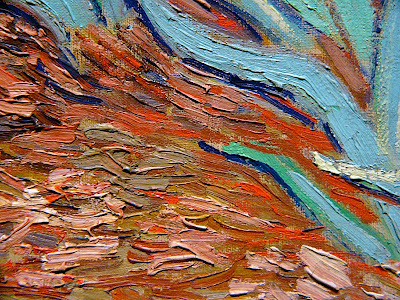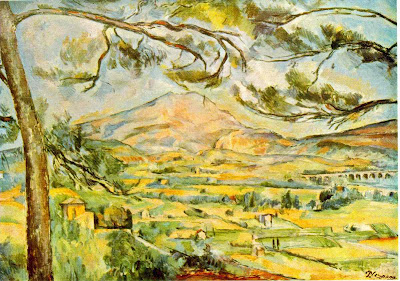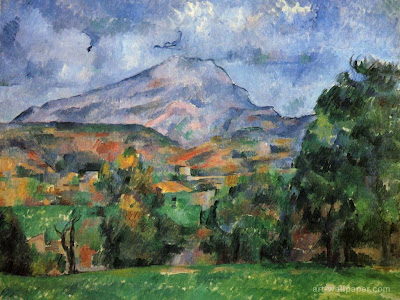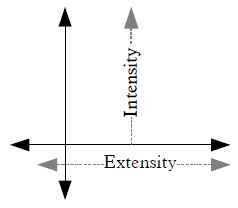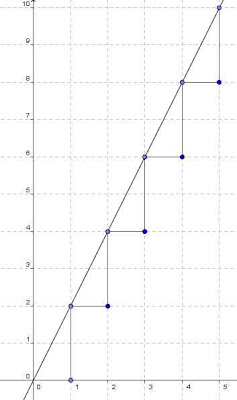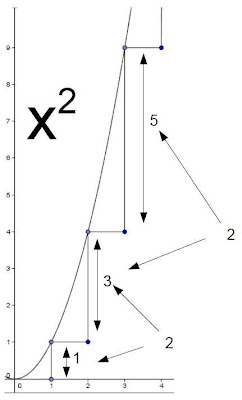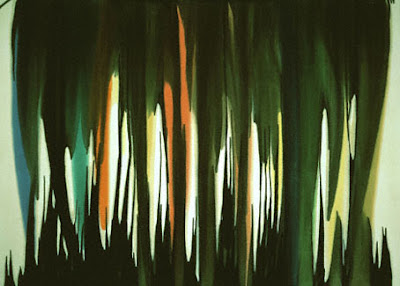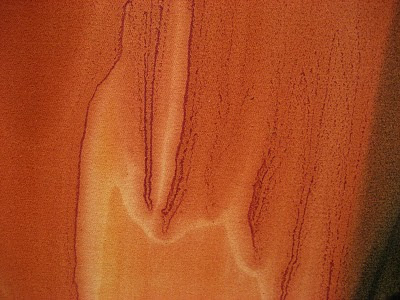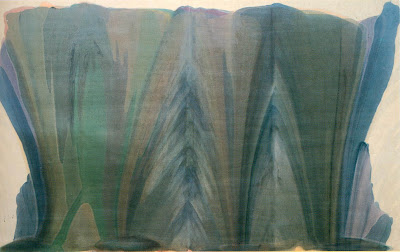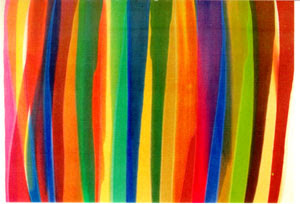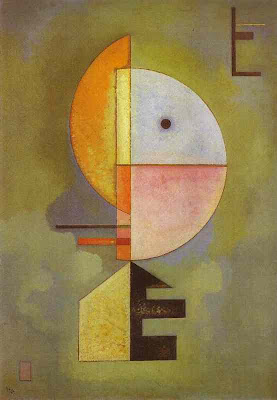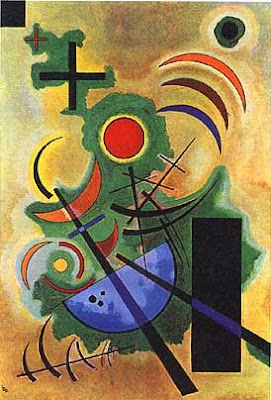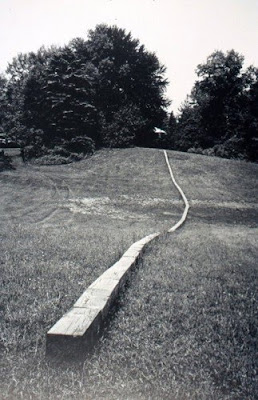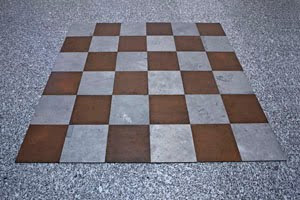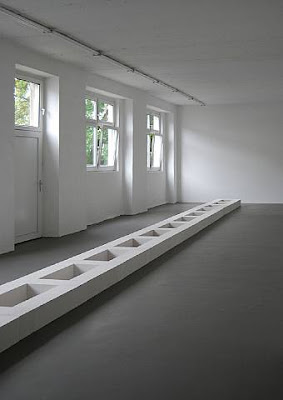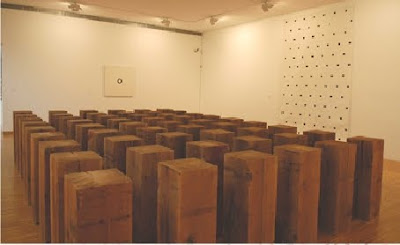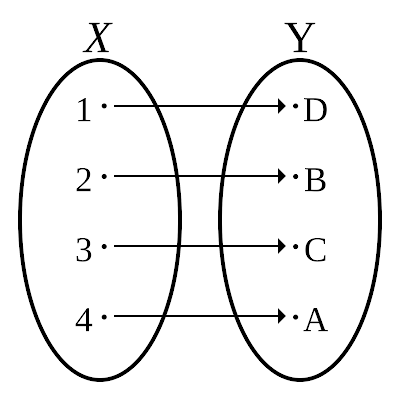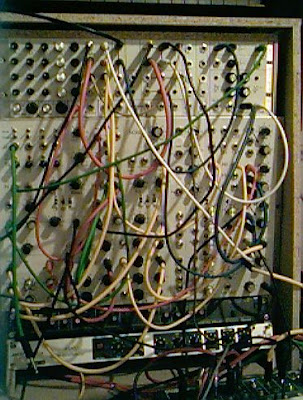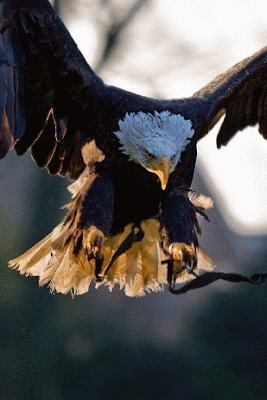Here is a clip showing Kandinsky painting.
We see then that there are discrete elements set in opposition to one another, rather than blurring or blending together continuously. This is like the discreteness of our fingers counted as digits. But also it seems that none of the images represent anything else. Nonetheless, Deleuze still sees coding in the digital component of abstract art. It has to do with how the oppositional relations between the parts of the painting affect us. It also involves the values already found in the spatial locations of the canvass (perhaps for example we might think of how images in the center of the canvass have more importance.) Some abstract painters formalized and articulated the way their paintings are 'coded' on the basis of placement and relation of the painting's discrete parts. Deleuze writes that this coding is something like computation; it involves calculating values to produce the desired affect, all without any representations. As Deleuze puts it, abstract art uses the fingers in the sense of the fingers that count.
Consider first the isolation of discrete parts of this dancer's form, and the way the angles of these parts produce a certain feeling in the image, in this case, unharmonic:
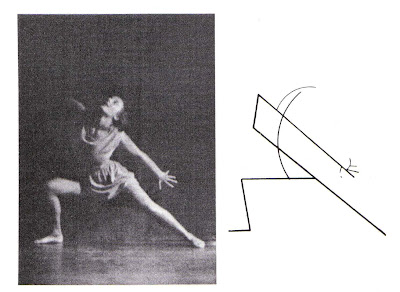
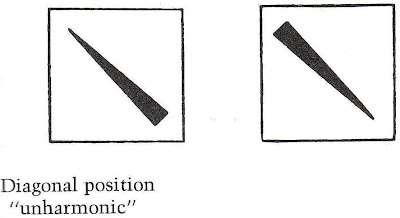
(From Kandinsky, Writings, p.520)
Perhaps in Kandinsky's paintings we might see something like the linear version of the dancer, without us seeing a dancer. But what we still might sense is the affect that the relations of its lines have on us. So there is coding without representation. There is also calculation. Consider this chart which calculates the distribution of tonal weight (darkness) between distinct parts of the canvass. Different affects will result from different numerical outcomes. So here we see that the painter's hand was not so much touching and putting itself into the paint as much as it was standing back and counting values in the service of the eye.
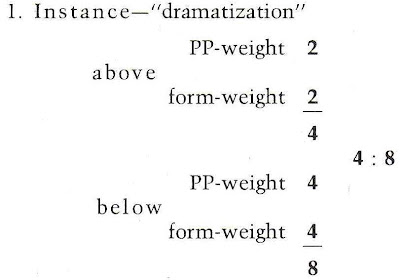
(From Kandinsky, Writings, p.665)
Thus the digital element in painting can be characterized by a subordination of the hand to the eye and discretely opposed parts that are coded for affect. Now let's see how the concept of diagram applies here. The diagram as we saw was what caused the painting's parts to differentially relate among themselves and for us to differentially relate with the painting's parts. Recall again our concrete example of the diagram in a painting.
Both the coding and this diagram here cause the parts to differentially relate. In this case of Van Gogh, the differential relations are created by the direct impact that the bendings have on the shape and apparent motion of the painting's parts. This is a visual impact. But we see it is not merely visual. The differential forces are acting directly on the strokes to cause them to want to move around, which results in our visually sensing them moving. However, the coding in abstract painting does not involve the coded parts differentially relating by means of contact of their differential forces. It is rather by means of binary relations that we interpret between discretely separate parts. So we can say that one property of the diagram is that it directly touches the painting's parts, and adds forces to them which cause them to tend to go in certain directions.
What if the diagrammatic influence touched every single stroke of the painting? What would result is action painting, also called abstract expressionism and art informel. Here we see the direct influence of the hand in its rawest physical motions. It touches every single part of the painting. With the optical geometry of the digital abstract painting, we can see clear outlines that divide the painting's parts, and our eyes can follow those lines without much difficulty. But try to follow the lines in Jackson Pollock's works.
Pollock. Untitled. Green and Silver
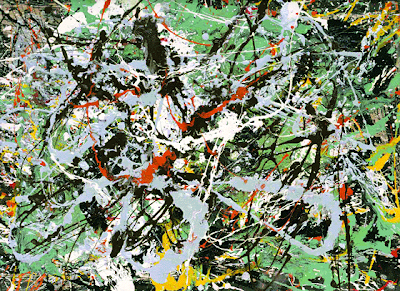
(Thanks Worthpoint)
In action painting, the lines are what Worringer calls the Northern Line or the Gothic Line. We first consider the "organically tinged ornament" of Classical Lines (Worringer 47b.d).
Classical ornament has organic clearness and moderation, and it seems to spring "without restraint from our sense of vitality." And also, "It has no expression beyond that which we give it" (48b). But now consider the Northern Lines of Gothic ornament.
Northern ornament, he says, seems to take on a life all its own, and in fact seems to act upon us ourselves.
The expression of northern ornament, on the other hand, is not immediately dependent upon us; here we face, rather, a life that seems to be independent of us, that makes exactions upon us and forces upon us an activity that we submit to only against our will. In short, the northern line is not alive because of an impression that we voluntarily impute to it, but it seems to have an inherent expression which is stronger than our life. (48bc, boldface mine)
We might say that the northern line is produced by the hand's own free self expression. It is not like drawing a line or curve with controlled movements. This we would see in digital abstract art. It is also the product of an organicism in the movements of our hand's parts and in the parts of the smooth controlled line that we draw. "The movement we make is of an unobstructed facility; the impulse once given, movement goes on without effort," he writes (48d). This pleasant feeling is a "freedom of creation," and we transfer it
involuntarily to the line itself, and what we have felt in executing it we ascribe to it as expression. In this case, then, we see in the line the expression of organic beauty just because the execution corresponded with our organic sense. (48-49, boldface mine)
But consider instead if we drew our line out of nervous agitation. We are constantly in defiance of what we just did in order to be as irregular as possible.
If we are filled with a strong inward excitement that we may express only on paper, the line scrawls will take an entirely different turn. The will of our wrist will not be consulted at all, but the pencil will travel wildly and impetuously over the paper, and instead of the beautiful, round, organically tempered curves, there will result a stiff, angular, repeatedly interrupted, jagged line of strongest expressive force. It is not the wrist that spontaneously creates the line; but it is our impetuous desire for expression which imperiously prescribes the wrist's movement. The impulse once given, the movement is not allowed to run its course along its natural direction, but it is again and again over whelmed by new impulses. When we become conscious of such an excited line, we inwardly follow out involuntarily the process of its execution, too. (49b.d, boldface mine)
But when we follow someone else's wild line, we do not feel pleasure. It seems more like "an outside dominant will coerced us" (49cd). What we feel seems like the forces of the ruptures in the line's incoherent discontinuity.
We are made aware of all the suppressions of natural movement. We feel at every point of rupture, at every change in direction, how the forces, suddenly checked in their natural course, are blocked, how after this moment of blockade they go over into a new direction of movement with a momentum augmented by the obstruction. The more frequent the breaks and the more obstructions thrown in, the more powerful becomes the seething at the individual interruptions, the more forceful becomes each time the surging in the new direction, the more mighty and irresistible becomes, in other words, the expression of the line. (49-50, boldface mine)
So consider when we were drawing the curved line. We felt physically a pleasure on account of there being no obstructions breaking the flow of our hand's movements. The parts of our wrist worked together to create a line that is self-consistent in its curving motion. With the erratic line, however, there seems to be unpredictable forces which break the flow, in fact prevent one from starting, and prevent any possibility of there being coherence in the motions or the line. Our hands drawing calmly seem to do so merely by means of our bodies acting automatically and with coordination among its parts. So when it is erratic, that suggests to us the forces causing the unpredictabilities do not come from the body, but rather from some psychic or spiritual source.
The essence of this inherent expression of the line is that it does not stand for sensuous and organic values, but for values of an unsensuous, that is, spiritual sort. No activity of organic will is expressed by it, but activity of psychical and spiritual will, which is still far from all union and agreement with the complexes of organic feeling. (50b, boldface mine)
Worringer clarifies that Gothic ornament and such a scrambled line made by an emotionally or mentally excited person are not at all the same things. However, Worringer will compare them to clarify what he means by the northern line. He says for example that the lines of northern cultures tell us that they were
longing to be absorbed in an unnatural intensified activity of a non-sensuous, spiritual sort one should remember in this connection the labyrinthic scholastic thinking in order to get free, in this exaltation, from the pressing sense of the constraint of actuality. (50d, boldface mine)
Now, notice how classical ornament exhibits symmetry.
However Gothic does not. But instead of symmetry, repetition is predominant. (52ab) Classical has repetition too, but like a mirroring. The repetitions have the "calm character of addition that never mars the symmetry" (52bc).
Gothic repetition, however, is more like a repetition of difference striving to rise to the nth power.
In the case of northern ornament, on the other hand, the repetition does not have this quiet character of addition, but has, so to speak, the character of multiplication. No desire for organic moderation and rest intervenes here. A constantly increasing activity without pauses and accents arises, and the repetition has only the one intention of raising the given motive to the power of infinity. The infinite melody of line hovers before the vision of northern man in his ornament, that infinite line which does not delight but stupefies and compels us to yield to it without resistance. If we close our eyes after looking at northern ornament, there remains only the echoing impression of incorporeal endless activity. (52-53, boldface mine)
Worringer then cites work from Lamprecht where he describes the labyrinthine nature of the Gothic lines.
Lamprecht speaks of the enigma of this northern intertwining band ornament, which one likes to puzzle over [PI. VIII]. But it is more than enigmatic; it is labyrinthic. It seems to have no beginning and no end, and especially no center; all those possibilities of orientation for organically adjusted feeling are lacking. We find no point where we can start in, no point where we can pause. Within this infinite activity every point is equivalent and all together are insignificant compared with the agitation reproduced by them. (53a.b, boldface mine)
As Deleuze puts it, the Gothic Line "does not go from one point to another, but passes between points, continually changing direction, and attains a power greater than 1, becoming adequate to the entire surface" (
Francis Bacon, 74ab). Let's explore a possible explanation for the line having a power greater than one (and we build again from this entry on Spinoza & rhythm). We first should explore some of Oresme's concepts that Deleuze refers us to. [For his discussions of Oresme, see Deleuze's Expressionism in Philosophy Ch 12 and his Cours Vincennes 10/03/1981]. Oresme invented a way to represent the intensities of qualities. We would now consider this to be variations between the x and y axis. Oresme called them longitude and latitude.
Consider if we plotted motion for example, with time as the x-axis and speed as the y-axis. And suppose that the object continues going at the same rate of motion. This will have its own 'form'. It will be like a rectangle, because there is no change in the intensity of the speed. Oresme calls this uniformity in intensity the latitudino uniformis.

(Thanks Jeff Babb)
Non-uniform rates of change, latitudo difformis, would be ones such as constant acceleration. Because the magnitude of intensity increases, we would figure it with a triangle or sloping straight line (Oresme 247B.c):
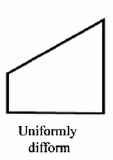
(Thanks Jeff Babb)
All other forms are ones whose non-uniform rate of change itself is not uniform. These are latitudo difformiter difformis, as for example an irregularly-paced rate of acceleration, which is always the case in the physical world. Oresme says of the difformly difform quality that “it can be described negatively as a quality which is not equally intense in all parts of the subject nor in which, when any three points of it are taken, the ratio of the excess of the first over the second to the excess of the second over the third is equal to the ratio of their distances.” Hence, if the latitudinal line is not smoothly straight, then it is difformly difformed. Latitudo difformiter difformis is “imaginable by means of figures otherwise disposed according to manifold variation (Oresme 248A.a; B.d):” 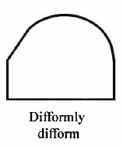
(Thanks Jeff Babb)
So to better understand why the Northern Line has a power greater than one, we will look to when Deleuze refers us to a concept of depotentialization, which he very well might have drawn from Hegel's calculus writings in the Science of Logic (especially§§569-570). Consider the graph below. If we just have y = x, then we just have a straight line, and not a curve.
But when we have y = x squared or y = the square root of x, then we have curves. What seems to allow for the function's line to curve is that there is a difference of power between them. In the case of y = x, they both tug on each other about the same amount throughout their variations. But in y = x squared, it is as though y pulls more-and-more on x as x increases, which is why the curve rapidly tilts upwards. So we might think of y having an increasing power, or having power of a higher order. For each standard unit of increase of y, it has an increased influence on x, and the magnitude of that influence itself increases with each unit. Deleuze refers to this as an acceleration. We will need to use this metaphorically to extract an idea we later use: we can only find the power relations on a variation if our line is curved, and we can only have a curved line if x and y have different powers in relation to one another.
Hegel writes of these values that "they are — or at least one of them is present in the equation in a higher power than the first” (Hegel, Science of Logic §613).
We can really think of this as a power struggle between the variables. Let's see why. Hegel continues.
at least one of those variables (or even all of them), is found in a power higher than the first; and here again it is a matter of indifference whether they are all of the same higher power or are of unequal powers; their specific indeterminateness which they have here consists solely in this, that in such a relation of powers they are functions of one another. (Hegel, Science of Logic §615, boldface mine).
power is taken as being within itself a relation or a system of relations. We said above that power is number which has reached the stage where it determines its own alteration, where its moments of unit and amount are identical — as previously shown, completely identical first in the square, formally (which makes no difference here) in higher powers. (Hegel, Science of Logic §615, boldface mine).
Let's consider first the function y = 2 which means that there is no relation of variance with x, so this is like Oresme's uniform motion:

(Thanks Jeff Babb)
Now we will consider the value for y = 2x:
Here we see that there is a relation of variance between x and y. As x increases, y increases doubly, but uniformly so; y is always twice x, so they are on the same level or power. This is like Oresme's uniformly difform motion.

(Thanks Jeff Babb)
Hegel says that there is no reason to differentiate a point on such a line, because it would be the same ratio as the line itself. Now we will consider the graph for x squared:
Here we see that the y value is not twice the x. This is because the y and the x do not relate to each other, rather the y relates only to the x squared. This is like Oresme's difformly difform motion.

(Thanks Jeff Babb)
In the x-squared diagram, we see that there is a continuous disproportioning of the relation between y and x, a continuous difforming that continuously doubles.
So we see that when one of the variables attains a power higher than one, there is a power struggle between the variations of the variables. It causes a change in the change, that is, a difformly difform variation. The Gothic Line is like this too. It has forces of different levels of power pushing and pulling it in a way that deforms it. Let's look closer at Pollock's lines to see this.
Pollock. Untitled. Green and Silver

(Thanks Worthpoint)
Pollock. Untitled. Green and Silver, details



(Thanks about.com / Shelley Esaak)
Pollock. Full Fathom Five
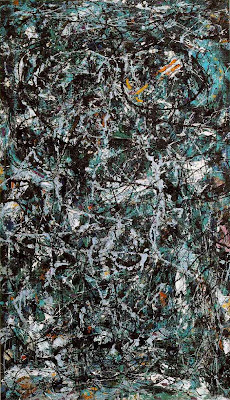
Pollock. Full Fathom Five, detail

(Thanks ibiblio)
What we see is not so much his eyes telling his hands what to do. Rather, it is his hands doing what they want to do. See how directly his hands are involved in the paint splatters, how his hands show themselves in the results.
Jackson Pollock painting
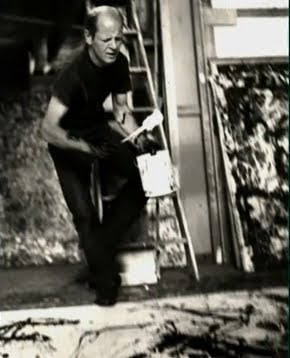
(Thanks Biography Channel)
Jackson Pollock painting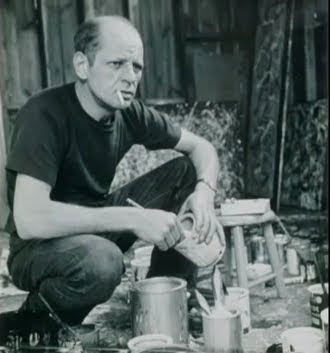
(Thanks Biography Channel)
Jackson Pollock painting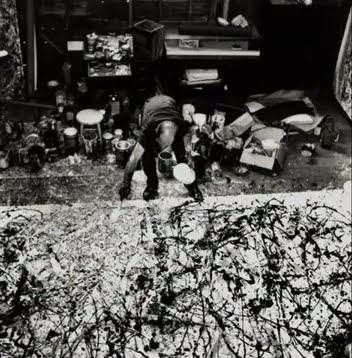
(Thanks Biography Channel)
Jackson Pollock painting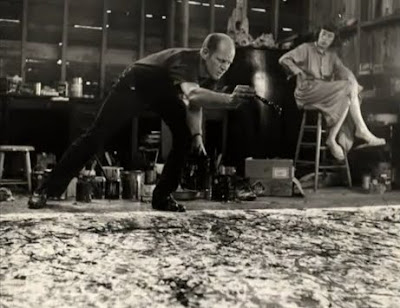
(Thanks Biography Channel)
Jackson Pollock painting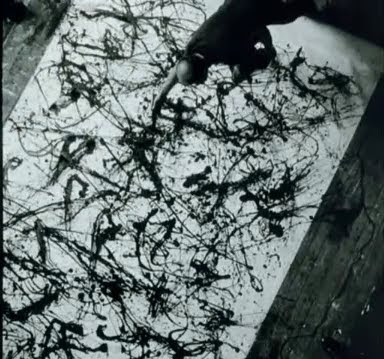
(Thanks Biography Channel)
Jackson Pollock painting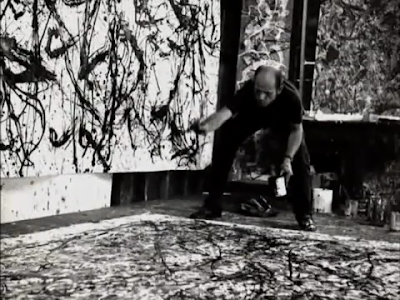
(Thanks Biography Channel)
Jackson Pollock painting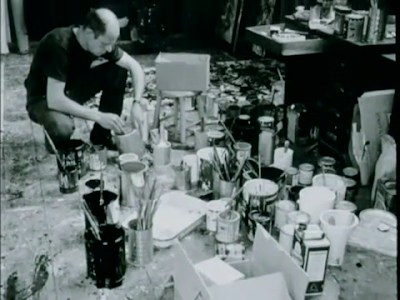
(Thanks Biography Channel)
Jackson Pollock painting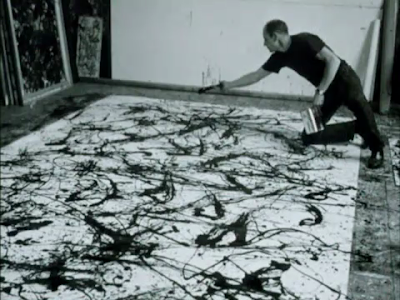
(Thanks Biography Channel)
Jackson Pollock painting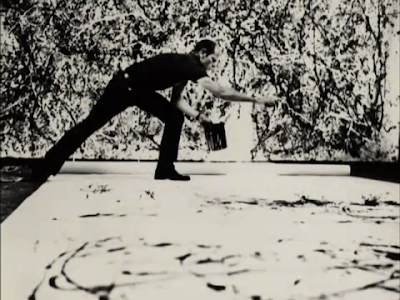
(Thanks Biography Channel)
Jackson Pollock painting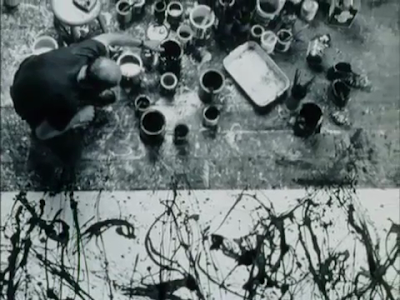
(Thanks Biography Channel)
Jackson Pollock painting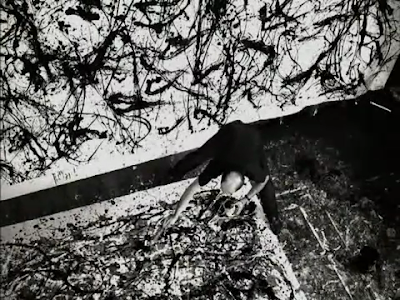
(Thanks Biography Channel)
Jackson Pollock painting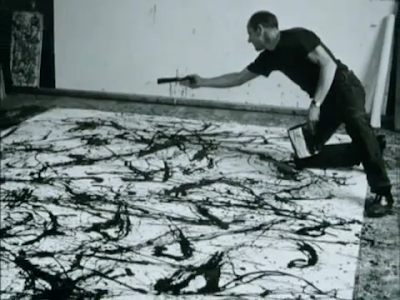
(Thanks Biography Channel)
Jackson Pollock painting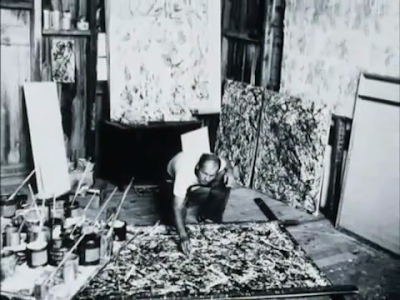
(Thanks Biography Channel)
In this clip we learn more about Pollock's drip techniques.
Jackson Pollock, his drip style, From Biography Channel
(Thanks Biography Channel/A&E)
Deleuze says we see this Gothic Line in Morris Louis's stains.
And Turner's later watercolors exhibit "the power of an explosive line without outline or contour, which makes the painting itself an unparalleled catastrophe" (74bc).
Turner. Oberwesel 1940
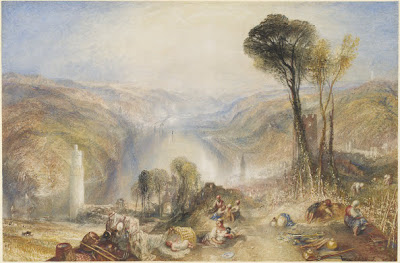
(Thanks watercolorblog.artistsnetwork.com)
Turner. The Burning of the Houses of Parliament, 1834
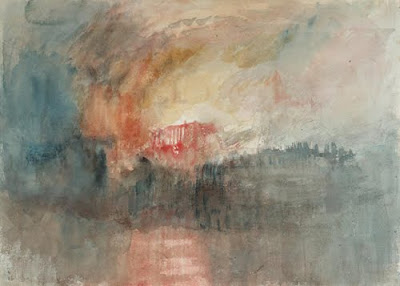
(Thanks nga.gov)
Turner. The Burning of the Houses of Parliament 1834

(Thanks tate.org.uk)
Turner. The Burning of the Houses of Parliament 1834

(Thanks tate.org.uk)
Turner. The Burning of the Houses of Parliament 1834

(Thanks tate.org.uk)
Turner 1775-1851 The Burning of the Houses of Parliament, from the River 1834

(Thanks tate.org.uk)
Turner 1775-1851 The Burning of the Houses of Parliament, from the River 1834

(Thanks tate.org.uk)
Turner Colour Study: The Burning of the Houses of Parliament 1834
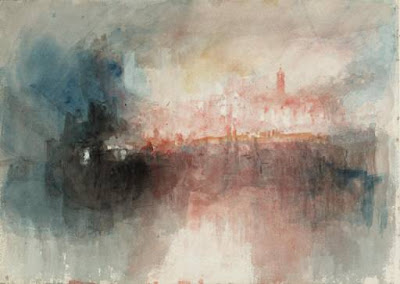
(Thanks tate.org.uk)
Turner Colour Study: The Burning of the Houses of Parliament 1834

(Thanks tate.org.uk)
The Burning of the Houses of Parliament, with Westminster Bridge 1834

(Thanks tate.org.uk)
or
Turner. The Burning of the Houses of Lords and Commons 1835

(Thanks wikimedia.org)Turner. Off Ramsgate 1940
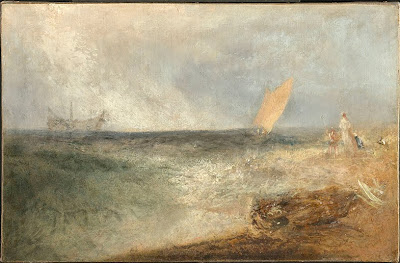
(Thanks thedrawingsite.com)
Turner. Sky and Sea c. 1826-9

(Thanks thedrawingsite.com)
Turner. Light and Color – Moses Writing the Book of Genesis
or
Light and Color (Goethe's Theory) - the Morning after the Deluge, exhibited 1843.

(Thanks arthistory.about.com)
(Thanks brooklynrail.org)
Turner. The Burning of the Houses of Parliament

(Thanks wikimedia.org)
Turner. Moonlight 1940

(Thanks terminartors.com)
Deleuze notes that even in Kandinsky we can find "nomadic lines without contour next to abstract geometric lines" (74c).
Even in Mondrian we can find the Gothic Line in way implied in our eye motions between the straight geometrical lines: "in Mondrian, the unequal thickness of the two sides of the square opened up a virtual diagonal without contours" (74c).
Mondrian. Composition II with Black Lines. Compositie nr.2 met swarte lijnen 1930

(Thanks Olga's Gallery)
Mondrian. Opposition of Lines, Red and Yellow. 1937

(Thanks timesonline)
Mondrian. One of The Diamond Compositions
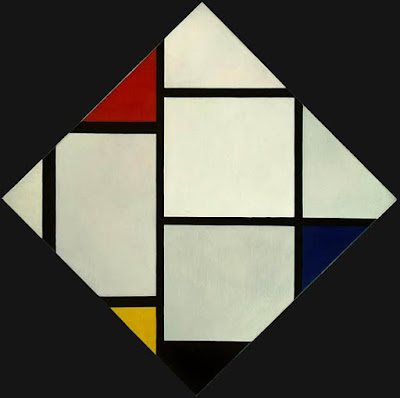
(Thanks National Gallery of Art)
Mondrian. Composition with Red, Blue and Yellow 1930

(Thanks Southern Baker)
Piet Mondrian. Composition with Blue, Red and Yellow - Compositie met blauw,rood en geel 1930

(Thanks Olga's Gallery)
But Pollock goes even further in decomposing the formation by means of the raw manual influences producing Gothic lines. On account of the diagrammatic push-and-pull forces of these lines, Pollock's painting "becomes a catastrophe-painting and a diagram-painting at one and the same time" (74cd). And it is also in this sort of painting that "modern man discovers rhythm" (74d). Why? In this sort of painting, the hand does not make use of formulaic ways to apply the paint. Rhythm we said was like when the swimmer must alter his own inner differences so to maintain a differential relation to the inner differences of the wave he swims through. And rhythm is like when a violin and piano must improvise together, each one responding to the other simultaneously. The hand works with the paint like it were a wave or another musician. The hand does not control the paint as much as it differentially relates itself with it. The hand must continually change what it does in order to handle those aspects of the paint which it leaves unmastered, unmanipulated. "The hand is liberated, and makes use of sticks, sponges, rags, syringes: action painting, the 'frenetic dance' of the painter around the painting, or rather in the painting, which is no longer stretched on an easel but nailed, unstretched, to the ground" (74-75). Deleuze also goes on to cite examples of how abstract expressionism developed after Pollock. It became "the elaboration of lines that are 'more' than lines, surfaces that are 'more' than surface, or, conversely, volumes that are 'less' than volumes (Carl André's planar sculptures, Robert Ryman's fibers, Martin Barré's laminated works, Christian Bonnefoi's strata)" (75a).
Now, even Mondrian's paintings defy the easel in a way, because they do not limit themselves to the boundaries of the outer frame. When hung on the wall, we come to see the patterns as extending outside the painting to relate to other parts of the wall. "In an abstraction of Mondrian's type, the painting ceases to be an organism or an isolated organization in order to become a division of its own surface, which must create its own relations with the divisions of the "room" in which it will be hung. In this sense, Mondrian's painting is not decorative but architectonic, and abandons the easel in order to become mural painting" (76b, boldface mine).
Mondrian. Gallery Wall 1
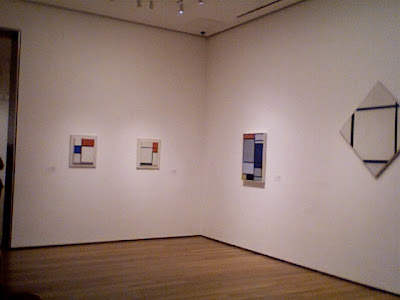
(Thanks doomlaser.com)
Mondrian. Broadway Boogie Woogie gallery wall.

(Thanks Mathew Beall)
Mondrian. gallery wall
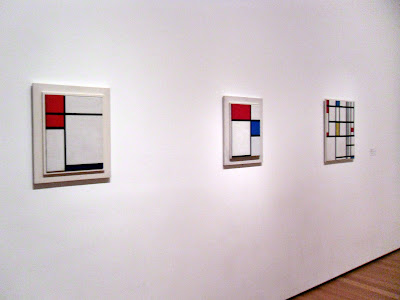
(Thanks Mathew Beall)
Mondrian. Gallery Wall

(Thanks Mathew Beall)
Mondrian. Victory Boogie-Woogie gallery wall

(Thanks Holland.com)
Mondrian. gallery wall

(Thanks Allie)
Mondrian. Tableau No. IV; Lozenge Compostion with Red, Gray, Blue, Yellow and Black gallery wall
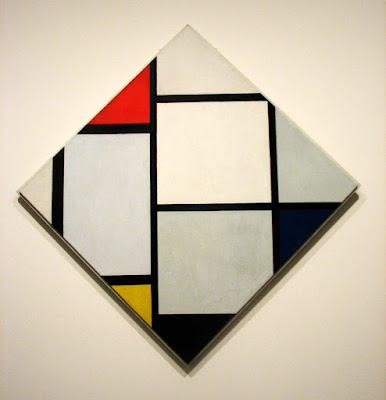
(Thanks Gilbert Musings)
But Pollock defies the easel in another way. Recall Kandinsky's formulas.

(From Kandinsky, Writings, p.665)
We see that certain sorts of things should go in certain places on the canvas. This means it is more probable to find certain things in their more proper locations. Also just think of how in general, the more important parts of the image are placed near the center of the canvass rather than at the edges or even slipping off the edges. However, look again at Jackson Pollock painting.
We see that he splatters the paint across the outer boundaries of the painting. For this reason, no part of the canvass is a preferred spot for certain contents. It is equally probable for some splatter to be found anywhere on the canvas, including sliding off from it or even falling outside it.
We will now look at analog and digital ways to create resemblances.
Deleuze says that both the analogical and the digital modes produce resemblances that are analogous to what they are reproducing.
Now, recall what we said above about Peirce's diagram: the relations between its parts are analogous to the relations of the represented things parts, even though there may be no sensible resemblance between the two. We then noted a difference between Peirce's and Deleuze's diagrams. In Deleuze's diagram, there is a sensible resemblance, but the relations between the parts are not analogous. For Peirce it is the inverse: there is no sensible resemblance, but the relations between the parts are analogous.
Deleuze says that digital reproduction produces an analogy by means of isomorphism. Let's walk through his explanation, using an example, to get a more precise understanding of what he means by isomorphism.
Recall Peirce's three types of signs: icons, indices, and symbols. Icons resemble their referent (a drawn pencil line resembles a geometrical line); Indices have a dynamic relation with their referent, in some cases by leaving an imprint of the one in the other (a bullet hole in a wooden moulding is a sign for the gun shot that made the hole); and Symbols represent their object by mans of a conventional rule or a habit.
We will now look at what makes an isomorphism, first in a somewhat technical manner. Consider two sets:
Set X's members: 1, 2, 3, 4
Set Y's members: A, B, C, D
We will then say that there is a function involved. Recall Edwards' & Penney's "Function Machine":
A function is like a machine that takes-in one value and gives-out another. In the case of our isomorphism, we will say that there is a function that takes-in members of the first set, and gives-out members of the other set. If we take-in '1' and give out 'D', we would represent this as:
f(1) = D.
Let's make the other assignments.
f(1) = D
f(2) = B
f(3) = C
f(4) = A
Wikipedia nicely represents this pictorially as:
We see that the assignments are arbitrary. We also notice that there is a one-to-one correspondence between the elements of the sets (Landsberg 58).
This then will help us understand how Deleuze means "analogy by isomorphism," when talking about digital coding. Let's take binary as an example of digital coding. There are two abstract elements, the one and the zero. [Perhaps they are abstract, because these numerals refer to discrete machine states, and thus the coding is something like an abstraction for the machine state; that is, its switches or whatever else are either in one or another position.]
Deleuze writes that we may "do at least three things with a code. One can make an intrinsic combination of abstract elements" (Deleuze 80c). So with our 1 and our 0, we may for example combine them to obtain:
0100100001100101011011000110110001101111
Deleuze continues, "One can also make a combination which will yield a 'message' or a 'narrative', that is, which will have an isomorphic relation to a referential set"(Deleuze 80c). So let's take our binary string as an example. We can for example break it into 8-bit parts.
01001000 01100101 01101100 01101100 01101111
Then, we can establish something like an isomorphic function to tell us how to convert these symbol-groups into letters. [Using the ASCII convention, we might say]
f(01001000) = H
f(01100101) = e
f(01101100) = l
f(01101100) = l
f(01101111) = o
[This example is taken from: docdroppers.org] In this way, our string "0100100001100101011011000110110001101111" can be converted into "Hello," on account of the isomorphism of the sets. In fact, the original string was composed intentionally for this translation. Deleuze then writes, "Finally, one can code the extrinsic elements in such a way that they would be reproduced in an autonomous manner by the intrinsic elements of the code (in portraits produced by a computer, for instance, and in every instance where one could speak of 'making a shorthand of figuration)' " (Deleuze 80c). The intrinsic elements seem in our case to be the 8-bit arrangements. And the extrinsic elements would be the letters. Computer software, running on the basis of binary codes, can automatically convert these binary sequences to the letters on our screens, just like how they convert the binary data of an image file to a picture we can see. So first we begin with "Hello" or some image. That is then converted to binary numerical codes for the letters or the homogenized square regions (pixels) of the image. The computer than by means of its own processes reproduces that original word or image, all mediated by the numerical code.
Notice how there is no resemblance between the letter formation and its isomorphic binary equivalent. And likewise with Deleuze's example, there is no resemblance between an image file's binary sequence and the image the software autonomously reproduces on our screen. Nonetheless, it is by means of this automatic reproduction that the resemblance to the original is produced, all through a medium, binary code, that bears no resemblance to the thing it codes and reproduces. But the thing it reproduces is similar to the thing that was originally rendered into code, so in a way the product is analogous to the original. Deleuze writes: "It seems, then, that a digital code covers certain forms of similitude or analogy: analogy by isomorphism, or analogy by produced resemblance" (80d).
Deleuze's point is that we cannot distinguish analog and digital by "saying that analogical language proceeds by resemblance, whereas the digital operates through code, convention, and combination of conventional units" (80c). This is because digital's isomorphism is analogous in a way, like Peirce's diagram. The isomorphic code preserves the relations between the original's parts, even though the isomorphism's parts do not resemble the original's parts.
But we will now consider pure analog reproductions. These make no use of code. Deleuze distinguishes two types. Consider first how when the resemblance is produced, there is some means by which it is done. If that means itself bears a likeness to what it reproduces, then 'resemblance is the producer.' In this case, the relations between the original's parts pass directly into its reproduced formation. Think for example of analog photography using film. The relations between the visual elements of the original image directly strike the chemical components of the film. Although it is in a negative form, the relations between the parts on the filmed image maintain the relations between parts of the original image, and this was all done on account of the original image directly affecting its medium. Now, it is true that there is a loss of fidelity in analog reproductions of this kind. But that does not change the fact that the result of this sort of reproduction is still a primary resemblance which allows for the reproduction to be taken as the likeness of the original. This will be more apparent when we contrast it to the next kind, which also involves an infidelity and resemblance.
Before we go on to resemblance as the product, Deleuze has us recall digital coding once again, because it almost fits this description. Recall how
0100100001100101011011000110110001101111
became
Hello
Notice in the first place how the number sequence bears no likeness to the word it produces (no likeness except for the isomorphic relation of its parts: H is to e as 01001000 is to 01100101, and so on). It is not like the Hello is some kind of imprint that we would expect from the number series. It rather seems like a 'brutal product' that is abruptly produced by the code. "resemblance is the product when it appears abruptly as the result of relations that are completely different from those it is supposed to reproduce: resemblance then emerges as the brutal product of nonresembling means. We have already seen an instance of this in one of the analogies of the code, in which the code reconstituted a resemblance as a function of its own internal elements" (81b). But the problem with coding is that the resemblance is already implied in the code. The last kind of reproduction has resemblance as the product, but unlike digital, no code is involved, and unlike analog, there is no primarily (formal and figurative) resemblance between the original and the reproduction. Some new appearance results with new relations between its parts. It is connected with the first only because a diagrammatic element modulates some part of the original so to produce something that does not formally resemble how it began, but our senses can feel that it is a deformation of the original. Any one part might 'sensibly resemble' the original part, but we see no clues that can help us trace it back the original form, so it is not a likeness. It just gives us a sensibly resembling sensation.
Deleuze will now explain analogical diagrams in terms of modulation, and he begins with the illustration of analog and digital synthesizers [For more on modulation and synthesizers, see this entry. And for more on the differences between analog and digital, see these entries here, especially this one here].
Analog synthesizers have different modules that affect the sound's properties in different ways.
In a sense, the sound signal is deformed by each module, as its properties are changed from its original form.
Digital synthesizers use integrated circuits, and they convert the sound wave to a homogenized form given a numerical code.
Integrated digital circuits do not process the electrical current as an analog of the sound wave, and it does not channel the flow from one module to another in the circuit. Rather, the wave is considered a quantity, and all the circuit's parts work together simultaneous to perform computational alterations to the code, so to produce the code for a modified wave.
Now let's return to Cézanne to better grasp this concept of modulation before moving to Francis Bacon. His motif was his incredible experience with the mountain he painted. He approaches the world as completely new, so that he may see its many nuances. In other worlds, he faces something purely different than anything he might expect. What he first sees arising from the field of pure variations are the geological structures. What he paints however are little color patches. He selects the colors that will produce in the viewer this feeling of having seen the mountain for the first time. We saw from the comparisons with the photographs of the mountain that there was a certain logic and coherence to the parts of the photographed mountain, but also a certain logic between the parts of the painting. But the painting's parts related more on the level of color sensations, and not formal elements.
Deleuze notes two sorts of modulation at work in Cézanne's painting. Notice first that Cézanne did not rely just on shading to portray depth. Instead he uses the oppositions of warm and cool tones, in some cases, to represent light and shadow or varying distances of objects (Turner 359).
Blue has no greater tone value than yellow when both are equally saturated, yet in certain contexts, when blue is painted next to yellow, it might suggest depth or volume (Conversations with Cézanne 191). To modulate the color would be for Cézanne to place a patch of one saturated color beside another, with their relation bringing about an effect determined not by some pre-set system but by the circumstances of their contextualization with the other color patches. (We can see in this Cézanne landscape below how the intense green on the horizon’s center recedes into the background. What is notable about this is that normally darkened colors seem like shadows and appear as though at a distance. Here we see that the intense green has not been darkened, and yet it colors the most distant place on the horizon).
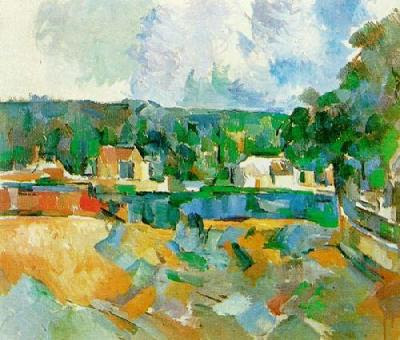
So the first sort of color modulation is Cézanne changing the colors from patch to patch, which produces depth in the painting, as if as our eyes move along the flat surface of the painting, our vision moves in-and-out of the depth the modulated colors create. The next sort is modulation involves the variations that the given impressions undergo as Cézanne converts them into pure color-relations. Here there is a sensible resemblance to the original, but deformed from it, or translated into a whole new language of color, depth, and sensation. It is in our experience with this color that our bodies meet the world as different from it and as made up entirely of differences. Deleuze locates Cézanne's modulation as being between the analogical and the digitally coded. It is not by code that the new colors induce sensations in us, but on account of their direct impact on our bodies. But it is not a pure and entire use of the manual-analogical, because he does not paint a chaos but rather an incoherence of colors that gives us the sensations of seeing the scene in its overwhelming pure differentiation.
"The 'middle' way, on the contrary is one that makes use of the diagram in order to constitute an analogical language. It assumes its complete independence with Cézanne. It is called a 'middle' way only from a very external point of view, since it implies just as much radical invention and destruction of figurative coordinates as the other ways. As an analogical language, painting has three dimensions: the planes, the connection or junction of planes (primarily of the vertical plane and the horizontal plane), which replaces perspective; color the modulation of color, which tends to suppress relations of value, chiaroscuro, and the contrast of shadow and light; and the body, the mass and declination of the body, which exceeds the organism and destroys the form-background relationship. There is a triple liberation here - of the body, of the planes, and of color (for what enslaves color is not only the contour, but also the contrast of values). Now this liberation can occur only by passing through the catastrophe; that is, through the diagram and its involuntary irruption: bodies are thrown off balance, they are in a state of perpetual fall; the planes collide with each other; colors become confused and no longer delimit an object. In order for the rupture with figurative resemblance to avoid perpetuating the catastrophe, in order for it to succeed in producing a more profound resemblance, the planes, starting with the diagram, must maintain their junction; the body's mass must integrate the imbalance in a deformation (neither transformation nor decomposition, but the 'place' of a force); and above all, modulation must find its true meaning and technical formula as the law of Analogy. It must act as a variable and continuous mold, which is not simply opposed to relief in chiaroscuro, but invents a new type of relief through color. And perhaps this modulation of color is Cezanne's principal operation. By substituting for relations of value a juxtaposition of tints brought together in the order of the spectrum, modulation will define a double movement of expansion and contraction - an expansion in which the planes, and especially the horizontal and the vertical planes, are connected and even merged in depth; and at the same tie, a contraction through which everything is restored to the body, to the mass, as a function of a point of imbalance or a fall. It is through such a system that geometry becomes sensible, and sensations become clear and durable: one has 'realized' the sensation says Cézanne." (82cd.83c, boldface mine)
Francis Bacon, Diagram, and Aesthetic Analogy
In the final chapter of Logic of Sensation, “The Eye and the Hand” (“L'œil et la main”) Deleuze begins by distinguishing the different ways that the hand is involved in artistic creation: the digital, the tactile, the manual proper, and the haptic, and these distinctions will help us better grasp what he means by aesthetic analogy. 1) In the digital functioning, the eye almost entirely subordinates the hand: the eye foresees and predetermines the forms that the hand passively and obediently renders. The eye operates perceptually and mentally, because it views an ideal optical space in the imagination. It then preconceives and designs the sorts of forms that will adequately index 2) the tactile referents, such as contour, depth, relief, and so on. These referents are the tangible features of objects which the optical elements referentially “code” through visual representations; and, referents along with their visual indices together constitute the tactile-optical space of the painting. Incorporating these tactile referents into the artwork requires a more ‘relaxed subordination’ of the hand to the eye. Doing so could be greatly magnified to result in the 3) manual proper, in which the hand is completely insubordinate to the eye. Although manually-rendered paintings remain a ‘visual reality,’ they impose upon sight a ‘space without form’ and a ‘movement without rest.’ Our eyes are largely unable to make sense of these manual features, thereby ‘dismantling’ the optical (108-109). Here Deleuze references Wöfflin’s notion of Gothic barbarian art, which ‘rebels against’ the domination of the optical and imposes upon it a ‘violent manual space,’ made possible when the hand is guided by a seemingly ‘foreign, imperious will’ that expresses itself in an ‘independent way (88). Lastly, 4) the haptic occurs when the manual is interjected into the tactile-optical space, but without overcoming it. This allows the eyes to still see tactile-optical images but also to feel the sensations they induce, and in this way, artists paint with their vision only insofar as they “touch with their eyes” (109).
Recall how Cézanne begins with the pure difference of what is given, and he modulates those differences into new differences of colors, so that we may experience the intensity of the pure givenness of the original scene. Francis Bacon has his own diagramming technique. When he begins to paint, he stands before a blank canvas. But like with Kandinsky, there are already certain givens such as probabilities how certain things will be arranged. Images flash into his mind, but they are like automatic associations, something blindly mechanical. They are clichés in the sense that they are what any person might visualize when beginning to paint, perhaps from having seen so many other paintings, for example, and getting a sense for what commonly is found on the canvas and where it is placed. Bacon imagines such formations on the canvas, and he then begins to paint them. But before they become too determinate, he then introduces differential mechanisms. Consider first the workings of a Rube Goldberg machine.
Rube Goldberg Machine
Each part is differentially related to the others. And some parts involve human behavior, which is not as predictable as a gear. And also, there are many seemingly superfluous connections, which increases the chances that the mechanism will operate in unexpected ways. Now watch the Rube Goldberg machine in The High Sign.
Buster Keaton's Dog-Gun Rube Goldberg Machine in The High Sign
Keaton could have directly connected the rope to the bell. But he adds the dog mechanism. This opens the chance for variations. And what we see is that the cat injects waves of differential variation throughout the machine's operation. In this way the cat-dog mechanism is like the diagram of the machine. It is catastrophic in the sense that the disruptions overload the system with an overabundance of differential variation.
Francis Bacon does something similar. He injects his proto-formed clichéd images with shocks of differential variation. It is a little bit like adding the manual-analog element of action painting to the digital-optical element of abstract art. So he might in an uncontrolled way splatter or smear the paint in some specific location of the painting. He then “surveys” the random markings as though they were graphs or diagrams that suggest new dimensions and images that he may superpose upon the given forms, new “possibilities of all types of fact being planted;”
for instance, if you think of a portrait, you maybe at one time have put the mouth somewhere, but you suddenly see through this graph that the mouth could go right across the face. And in a way you would love to be able in a portrait to make a Sahara of the appearance... seeming to have the distances of the Sahara. (Bacon & Sylvester 56)
He then describes how this process brought about his Painting, 1946. It began as a bird alighting on a field, and resulted as the sensational butchery scene it became.
Francis Bacon:
Well, one of the pictures I did in 1946, the one like a butcher's shop, came to me as an accident. I was attempting to make a bird alighting on a field. And it may have been bound up in some way with the three forms that had gone before, but suddenly the lines that I'd drawn suggested something totally different, and out of this suggestion arouse this picture. I had no intention to do this picture; I never thought of it in that way. It was like one continuous accident mounting on top of another.
Painting, 1946
FB:
It suddenly suggested an opening-up into another area of feeling altogether. And then I made these things, I gradually made them. So that I don't think the bird suggested the umbrella; it suddenly suggested this whole image. And I carried it out very quickly, in about three or four days. (Bacon & Sylvester 11)
Now let's look at Deleuze's description of this process.
Let us begin with tactile-optical space [...]. Now what will disrupt this space and its consequences, in a catastrophe, is the manual "diagram," which is made up exclusively of insubordinate color-patches and traits. And something must emerge from this diagram, and present itself to view. Roughly speaking, the law of the diagram, according to Bacon, is this: one starts with a figurative form, a diagram intervenes and scrambles it, and a form of a completely different nature emerges from the diagram, which is called the Figure.
Bacon first cites two examples. [Footnote 4] In the 1946 Painting [3], he had wanted "to make a bird alighting on a field," but the lines he had drawn suddenly took on a kind of independence and suggested "something totally different," the man under the umbrella. And in the portraits of heads, the painter looks for organic resemblance, but sometimes "the paint moving from one contour into another" happens to liberate a more profound resemblance in which the organs (eyes, nose, mouth) can no longer be discerned. Precisely because the diagram is not a coded formula, these two extreme examples allow us to bring out the complementary dimensions of the operation.
We might assume that the diagram makes us pass from one form to another - for example, from a bird-form to an umbrella-form - and thus that it acts as an agent of transformation. But this is not the case in the portraits, where we move across only a single form. [109-110] And with regard to Painting [3], Bacon even states explicitly that we do not pass from one form to another. In effect, the bird exists primarily in the intention of the painter, and it gives way to the whole of the really executed painting or, if one prefers, to the umbrella series - man below, meat above. Moreover, the diagram can be found, not at the level of the umbrella, but in the scrambled zone, below and to the left, and it communicates with the whole through the black shore. It is from the diagram - at the center of the painting, at the point of close viewing - that the entire series emerges as a series of accidents "mounting on top of another." [Footnote 5] If we start with the bird as an intentional figurative form, we see that the what corresponds to this form in the painting, what is truly analogous to it, is not the umbrella-form (which merely defines a figurative analogy or an analogy or resemblance), but the series or the figural whole, which constitutes the specifically aesthetic analogy: the arms of the meat which are raised as analogues to wings, the sections of the umbrella which are falling or closing, the mouth of the man as a jagged beak. What is substituted for the bird is not another form, but completely different relations, which create a complete Figure as the aesthetic analogue of the bird (relations between the arms of the meat, the sections of the umbrella, the mouth of the man). The diagram-accident has scrambled the intentional figurative form, the bird: it imposes nonformal color-patches and traits that function only as traits of birdness, of animality. It is from these nonfigurative traits that the final whole emerges, as if from a pool; and it is they that raise to it the power of the pure Figure, beyond the figuration contained in this whole. Thus the diagram acted by imposing a zone of objective indiscernibility or indeterminability between two forms, one of which was no longer, and the other, not yet: it destroys the figuration of the first and neutralizes that of the second. And between the two, it imposes the Figure, through its original relations. There is indeed a change of form, but the change of form is a deformation; that is, a creation of original relations which are substituted for the form: the meat that flows, the umbrella that seizes, the mouth that is made jagged. As the song says, "I'm changing my shape, I feel like an accident." [footnote 6] The diagram has introduced or distributed formless forces throughout the painting, which have a necessary relation with the deformed parts, or which are made use of as, precisely, "places." (Deleuze 109b; 109c-110d)
Partons de l'espace tactile-optique [...] Or c'est avec cet espace et avec ses conséquences que le « diagramme » manuel rompt en catastrophe, lui qui consiste uniquement en taches et traits insubordonnés. Et quelque chose doit sortir du diagramme, à vue. En gros, la loi du diagramme selon Bacon est celle-ci : on part d'une forme figurative, un diagramme intervient pour la brouiller, et il doit en sortir une forme d'une tout autre nature, nommée Figure.
Bacon cite d'abord deux cas [note 146]. Dans « Peinture » de 1946, il voulait « faire un oiseau en train de se poser dans un champ », mais les traits tracés ont pris soudain une sorte d'indépendance, et suggéré « quelque chose de tout à fait différent », l'homme au parapluie. Et dans les portraits de têtes, le peintre cherche la ressemblance organique, mail il arrive que « le mouvement même de la peinture d'un contour à un autre » libère une ressemblance plus profonde où l'on ne peut plus discerner d'organes, yeux, nez ou bouche. Justement parce que le diagramme n'est pas une formule codée, ces deux cas extrêmes doivent nous permettre dégager les dimensions complémentaires de l'opération.
On pourrait croire que le diagramme nous fait passer d'une forme à une autre, par exemple d'une forme-oiseau à une forme-parapluie, et agit en ce sens comme un agent de transformation. Mais ce n'est pas le cas des portraits, où l'on va seulement d'un bord à l'autre d'une même forme. Et même pour « Peinture », Bacon dit explicitement qu'on ne passe pas d'une forme à une autre. En effet, l'oiseau existe surtout dans l'intention du peintre, et il fait place à l'ensemble du tableau réellement exécuté, ou, si l'on préfère, à la série parapluie - homme en dessous - viande au-dessus. Le diagramme d'ailleurs n'est pas au niveau du parapluie, mais dans la zone brouillée, plus bas, un peu à gauche, et communique avec l'ensemble par la plage noire : c'est lui, foyer du tableau, point de vision rapprochée, dont sort toute la série comme série d'accidents « montant les uns sur la tête des autres » [note 147]. Si l'on part de l'oiseau comme forme figurative intentionnelle, on voit ce qui correspond à cette forme dans le tableau, ce qui lui est vraiment analogue, ce n'est pas la forme-parapluie (qui définirait seulement une analogie figurative ou de ressemblance), mais c'est la série ou l'ensemble figural, qui constitue l'analogie proprement esthétique : les bras de la viande qui se lèvent comme analogues d'ailes, les tranches de parapluie qui tombent ou se ferment, la bouche de l'homme comme un bec dentelé. À l'oiseau se sont substitués, non pas une autre forme, mais des rapports tout différents, qui engendrent l'ensemble d'une Figure comme l'analogue esthétique de l'oiseau (rapports entre bras de la viande, tranches du parapluie, bouche de l'homme). Le diagramme-accident a brouillé la forme figurative intentionnelle, l'oiseau : il impose des taches et traits informels, qui fonctionnent seulement comme des traits d'oisellité, d'animalité. Et ce sont ces traits non figuratifs dont, comme d'une flaque, sort l'ensemble d'arrivée, et qui, par-delà la figuration propre à cet ensemble à son tour, l'élèvent à la puissance de pure Figure. Le diagramme a donc agi en imposant une zone d'indiscernabilité ou d'indéterminabilité objective entre deux formes, dont l'une n'était déjà plus, et l'autre, pas encore : il détruit la figuration de l'une et neutralise celle de l'autre. Et entre les deux, il impose la Figure, sous ses rapports originaux. Il y a bien changement de forme, mais le changement de forme est déformation, c'est-à-dire création de rapports originaux substitués à la forme : la viande qui ruisselle, le parapluie qui happe, la bouche qui se dentelle. Comme dit une chanson, I'm changing my shape, I feel like an accident. Le diagramme a induit ou réparti dans tout le tableau les forces informelles avec lesquelles les parties déformées sont nécessairement en rapport, ou auxquelles elles servent précisément de « lieux ». [Deleuze 146b; 146c-148b]
The essential point about the diagram is that it is made in order for something to emerge from it, and if nothing emerges from it, it fails. And what emerges from the diagram, the Figure, emerges both gradually and all at once, as in Painting [3], where the whole is given all at once, while the series is at the same time constructed gradually. [Deleuze 111d]
L'essentiel du diagramme, c'est qu'il est fait pour que quelque chose en sorte, et il rate si rien n'en sorte. Et ce qui sort du diagramme, la Figure, en sort à la fois graduellement et tout d'un coup, comme pour « Peinture » où l'ensemble est donné d'un coup, en même temps que la série, construite graduellement. [Deleuze 149cd]
So what we see is that the new formation has modulated parts, which means they are deformations. They no longer referentially refer to their originals, but they hit our senses in a similar way. Yet, unlike a Peircean diagram, the relations between the parts have not been maintained. The relation between a bird head and its beak is not the same relation at all between an umbrella and a skull.
So let's first imagine Bacon beginning with the eagle image, but not in such a completed form as this.
Then he smears the paint in the lower left area.
Francis Bacon's Diagram: Detail From Painting, 1946
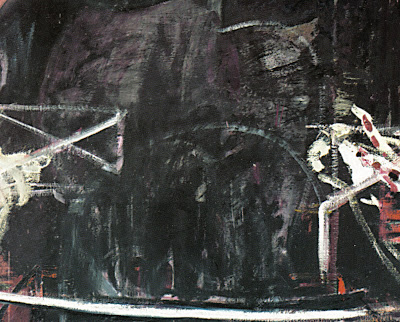
This is a catastrophe like the cat entering the machine. It sets off a chain reaction of differential variations disrupting and deforming the images. Look here first at the next layer of differential variation that the diagram immediately produces.
Francis Bacon's Catastrophe: Detail From Painting, 1946
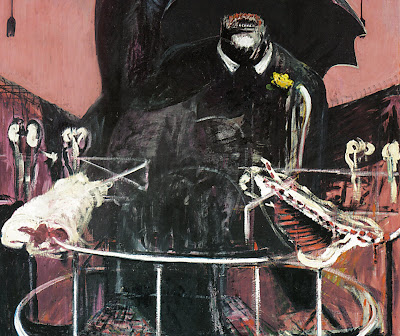
(Thanks www.sai.msu.su)
Here we might imagine the chain of catastrophe.
What results then are aesthetic analogs: the skull to the beak, the head to the umbrella, the wings to the meat limbs. These are already non-representation deformations, because they were caused by analog modulations under the influence of an impacting wave of differential variation. But now, the coherence between the parts has broken down.
Francis Bacon and Diagram in Painting 1946
So on account of the aesthetic analogousness of the two paintings, we sense somehow hints of an organization. This causes us to want to find out how the parts fit together. But the way we want to put them together (in a somewhat birdlike way) does not comply with the new variations. Our bodies keep trying to rhythmically differentiate themselves to adjust to the incoming variations, but the painting does not allow any coherence to result despite our best efforts. In this way, we experience that Spinozistic rhythm, like when first switching from a walking to a swimming mode of behavior or when two instruments must mutually improvise over-against one another.
Texts cited:
ASCII alphabet code:
http://www.tekmom.com/buzzwords/binaryalphabet.html
Bacon, Francis & David Sylvester. The Brutality of Fact: Interviews with Francis Bacon. New York: Thames & Hudson, 1987.
More information from the publisher here:
Cézanne, Paul. Letters. Transl. Marguerite Kay. Ed. John Rewald. Oxford: Bruno Cassirer, 1976.
Conversations with Cézanne. Ed. Michael Doran. Berkeley: University of California Press, 2001.
Deleuze, Gilles. Francis Bacon: The Logic of Sensation. Transl. Daniel W. Smith. London/New York: Continuum, 2003.
Deleuze, Gilles. Francis Bacon: Logique de la sensation. Paris: Seuil, 2002.
Hello example:
http://www.docdroppers.org/wiki/index.php?title=Learning_Binary
Hegel. Science of Logic. Transl. A.V. Miller. George Allen & Unwin, 1969.
Text available online at:
http://www.marxists.org/reference/archive/hegel/index.htm
Kandinsky, Wassily. Kandinsky: Complete Writings on Art. Ed. Kenneth C. Lindsay & Peter Vergo. Boston: Da Capo Press, 1994.
Landsberg, Marge E. Syntactic iconicity and linguistic freezes: The human dimension. Berlin/New York: Mouton de Gruyter/Walter de Gruyter, 1995.
Possible preview at:
http://books.google.com/books?id=xgXh7rAz0E8C&dq=Marge+E.+Landsberg&source=gbs_navlinks_s
Machotka Pavel. Cézanne: Landscape into Art.
http://www.machotka.com/library/landscapetoart/index.htm
McDowell. Maxson J. "Pictorial Space throughout Art History: Cézanne and Hofmann." McDowell, 2006.
http://www.jungny.com/PlasticStructure.html#cez%20motif
Oresme. “The Configuration of Qualities and Motions, Including a Geometrical Proof of the Mean Speed Theorem” in A Source Book in Medieval Science. Ed Edward Grant. Harvard University Press, 1974.
Turner, Norman. “Cézanne, Wagner, Modulation.”
The Journal of Aesthetics and Art Criticism, Vol. 56, No. 4, Autumn, 1998.
Wilhelm Worringer. Form Problems of the Gothic. New York: G.E. Stechert, 1920.
PDF available online at:
http://www.archive.org/details/formproblemsofth00worruoft
Wright, Charles. "Halflife: A Commonplace Notebook," in Charles Wright, Halflife: Improvisations and Interviews, 1977-1987 (Ann Arbor: U Michigan P).
http://www.english.illinois.edu/maps/poets/s_z/c_wright/notebook.htm
Image sources (with all my deepest gratitude, thanks so very much):
Analog Modular Synthesizer, vertical image
http://www.analog-synth.de/synths/formant.htm
(Thanks analog-synth.de)
Analog Modular Synthesizer, square image
http://theatreorgans.com/walnuthill/wall-frankvanaman.htm
http://www.synthtech.com/motm.html
André. Carl André. Secant 1977
http://www.orchardprojects.com/index.php/artistconversation/aram_moshayedi_and_jedediah_caesar/
(Thanks The Orchard Projects)
André. Carl André. Magnesium Copper Plain. 1979
http://www.museoreinasofia.es/programas-publicos/educacion/adultos/teatro_en.html
(Thanks museoreinasofia.es)
André. Carl André. Lament for the Children. 1976-1996
http://www.artnet.com/Galleries/Artwork_Detail.asp?G=&gid=264&which=&aid=1516&wid=425640779&source=inventory&rta=http://www.artnet.com
(Thanks artnet.com)
André. Carl André. Lament for the Children 2. 1976-1996
http://www.artnet.com/magazineus/reviews/robinson/robinson6-3-08_detail.asp?picnum=5
(Thanks artnet.com)
André. Carl André. Lament for the Children 3. 1976-1996
http://www.designboom.com/snapshot/gallery.php?SNAPSHOT_ID=14&GALLERY_ID=797
(Thanks designboom.com)
André. Carl André. Blacks Creek 1978
http://stephan.barron.free.fr/1/guyader_karine/carlandre-k.htm
(Thanks stephan.barron.free.fr)
André. Carl André. 4-Segment Hexagon 1974
http://stephan.barron.free.fr/1/guyader_karine/carlandre-k.htm
(Thanks stephan.barron.free.fr)
André. Carl André. 36 copper square 1968
http://www.artnet.com/Artists/LotDetailPage.aspx?lot_id=640B1A046B2F2CAC96B9BFE7AFA4D11D
(Thanks artnet.com)
André. Carl André. Blue belgian granite 1986
http://www.artnet.com/artwork/426081583/423941488/carl-andre-breda.html
(Thanks artnet.com)
André. Carl André. ALCLOUD 2001
http://www.artnet.com/artwork/426066054/115807/carl-andre-alcloud.html
(Thanks artnet.com)
André. Carl André. Sculpture 43 Roaring forty 1968
André. Carl André. Sculpture 43 Roaring forty 1968
http://www.moreeuw.com/histoire-art/biographie-carl-andre.htm
(Thanks moreeuw.com)
André. Carl André. Ferox 1982
http://www.artnet.com/Galleries/Artwork_Detail.asp?G=&gid=264&which=&ViewArtistBy=&aid=1516&wid=424542170&source=artist&rta=http://www.artnet.com
(Thanks artnet.com)
André. Carl André. 41st Dolomite Integer + Trier 1985-1987
http://www.artnet.com/Galleries/Artwork_Detail.asp?G=&gid=117335&which=&ViewArtistBy=&aid=1516&wid=425998340&source=artist&rta=http://www.artnet.com
(Thanks artnet.com)
André. Carl André. From Map of Poetry @Autobiography 1966
http://www.artnet.com/Galleries/Artwork_Detail.asp?G=&gid=117335&which=&ViewArtistBy=&aid=1516&wid=424823018&source=artist&rta=http://www.artnet.com
(Thanks artnet.com)
André. Carl André. 45th Dolomite Integer 1985
http://www.artnet.com/Galleries/Artwork_Detail.asp?G=&gid=117335&which=&ViewArtistBy=&aid=1516&wid=425998343&source=artist&rta=http://www.artnet.com
(Thanks artnet.com)
André. Carl André. From Map of Poetry Sculpture Words 1966
http://www.artnet.com/Galleries/Artwork_Detail.asp?G=&gid=117335&which=&ViewArtistBy=&aid=1516&wid=425929805&source=artist&rta=http://www.artnet.com
(Thanks artnet.com)
André. Carl André. Other Piece 1983
http://www.artnet.com/Galleries/Artwork_Detail.asp?G=&gid=117335&which=&ViewArtistBy=&aid=1516&wid=426008052&source=artist&rta=http://www.artnet.com
(Thanks artnet.com)
André. Carl André. Outer Piece 1983
http://www.artnet.com/Galleries/Artwork_Detail.asp?G=&gid=117335&which=&ViewArtistBy=&aid=1516&wid=425998346&source=artist&rta=http://www.artnet.com
(Thanks artnet.com)
André. Carl André. Flander field 1978
http://www.museedegrenoble.fr/salle9.htm
(Thanks museedegrenoble.fr)
André. Carl André. Convex Pyramid 1959-2000
http://www.artnet.com/Galleries/Artwork_Detail.asp?G=&gid=115807&which=&ViewArtistBy=&aid=1516&wid=425386217&source=artist&rta=http://www.artnet.com
(Thanks artnet.com)
André. Carl André. J O U R A F O 1972
http://www.artnet.com/Galleries/Artwork_Detail.asp?G=&gid=115807&which=&ViewArtistBy=&aid=1516&wid=426029891&source=artist&rta=http://www.artnet.com
(Thanks artnet.com)
André. Carl André. The Void Enclosed by Lead & Copper Squares of Three, Four, & Five 1998
http://www.paulacoopergallery.com/artists/1/works/913
(Thanks paulacoopergallery.com)
Astronomy Picture of the Day 2008 September 25
http://apod.nasa.gov/apod/ap080925.html
Thanks NASA
Bacon, Francis. Painting 1946
(c) 2009 The Estate of Francis Bacon/ARS, New York/DACS, London
Cézanne. Mont Sainte Victoire. 1
http://www.ibiblio.org/wm/paint/auth/cezanne/st-victoire/1885/
Thanks WebMuseum
Cézanne. Mont Sainte Victoire. 2
http://www.artchive.com/artchive/C/cezanne/mt_s-v_4.jpg.html
(Thanks Artchive)
Cézanne. Mont Sainte Victoire. 3
http://www.ibiblio.org/wm/paint/auth/cezanne/st-victoire/1886/cezanne.st-victoire-1886.jpg
(Thanks WebMuseum)
Cézanne. Mont Sainte Victoire. 4
http://www.theartwolf.com/articles/50-impressionist-paintings.htm
(Thanks G. Fernández - theartwolf.com)
Cézanne. Mont Sainte Victoire. 5
http://commons.wikimedia.org/wiki/File:Paul_Cezanne_La_Montagne_Saint_Victoire_Barnes.jpg
(Thanks wiki)
Cézanne. Mont Sainte Victoire. 6
http://picasaweb.google.com/lh/photo/6-qX6f8UwGavQ_Sd_MDygA
(Thanks Leonard Dixon)
Cézanne. Mont Sainte Victoire. 7
http://www.shafe.co.uk/art/Paul_Cezanne-_Mont_Sainte-Victoire_%281904-6%29.asp
(Thanks Laurence Shafe)
Cézanne. Mont Sainte Victoire. 8
http://www.pluswallpapers.com/art/painting.htm
(Thanks pluswallpapers.com)
Cézanne. Mont Sainte Victoire. 9
http://german.lss.wisc.edu/~smoedersheim/gr947/links.htm
(Thanks german.lss.wisc.edu)
Cézanne. Mont Sainte Victoire. 10
http://commons.wikimedia.org/wiki/File:Paul_C%C3%A9zanne_-_Mont_Sainte-Victoire_and_Chateau_Noir_%28Bridgestone_Museum%29.jpg
(Thanks wiki)
Cézanne. Mont Sainte Victoire. 11
http://www.ibiblio.org/wm/paint/auth/cezanne/st-victoire/cezanne.lauves-802.jpg
(Thanks ibiblio)
Cézanne. Mont Sainte Victoire. 12
http://dbeveridge.web.wesleyan.edu/wescourses/2001f/chem160/01/Mont-Sainte_Victoire/pages/Cezanne%27s_MSV,_1897.htm
(Thanks dbeveridge.web.wesleyan.edu)
Cézanne. Mont Sainte Victoire. 13
http://www.oceansbridge.com/oil-paintings/product/96358
(Thanks oceansbridge.com)
Cézanne. Mont Sainte Victoire. 14
http://www.art-wallpaper.com/3942/C%C3%A9zanne+Paul/Montagne+Saint-Victoire?Width=1024&Height=768
(Thanks art-wallpaper.com)
Cézanne. Mont Sainte Victoire. 15
http://commons.wikimedia.org/wiki/File:Cezanne_-_Mont_Sainte_Victoire_von_Lauves_aus_gesehen_2.jpg
(Thanks wiki)
Cézanne. Mont Sainte Victoire. 16
http://www.ibiblio.org/wm/paint/auth/cezanne/st-victoire/
(Thanks Webmuseum)
Cézanne. Mont Sainte Victoire. 17
http://www.dpcdsb.org/IONAS/Courses/Visual+Arts+Gr+12.htm
(Thanks Iona)
Cézanne. Mont Sainte Victoire. 18
http://commons.wikimedia.org/wiki/File:Cezanne_-_Mont_Sainte_Victoire_von_Lauves_aus_gesehen_1.jpg
(Thanks wiki)
Cézanne. Mont Sainte Victoire. 19
http://commons.wikimedia.org/wiki/File:Cezanne_-_Ebene_mit_dem_Mont_Sainte_Victoire.jpg
(Thanks wiki)
Cézanne. Mont Sainte Victoire. 20
http://commons.wikimedia.org/wiki/File:Paul_C%C3%A9zanne,_Mont_Sainte-Victoire.jpg
(Thanks wiki)
Cézanne. Mont Sainte Victoire. 21
http://commons.wikimedia.org/wiki/File:Paul_Cezanne_-_Mont_Sainte-Victoire_1897.jpg
(Thanks wiki)
Cézanne. Mont Sainte Victoire. 22
http://commons.wikimedia.org/wiki/File:Mont_Sainte-Victoire_with_Large_Pine_1886-1887_Paul_Cezzane.jpg
(Thanks wiki)
Cézanne. Mont Sainte Victoire. 23
http://commons.wikimedia.org/wiki/File:Paul_C%C3%A9zanne_109.jpg
(Thanks wiki)
Cézanne. Mont Sainte Victoire. 24
http://www.paintingmania.com/mont-sainte-victoire-seen-gardanne-13_5352.html
(Thanks painting mania)
Cézanne. Mont Sainte Victoire. 25
http://commons.wikimedia.org/wiki/File:Paul_C%C3%A9zanne_110.jpg
(Thanks wiki)
Cézanne. Mont Sainte Victoire 26
http://www.artnet.com/artists/lotdetailpage.aspx?lot_id=B227803AD7A62169
(Thanks Artnet)
Cézanne. Plain by Mount Sainte-Victoire, 27
http://www.paintinghere.com/painting/Plain_by_Mount_Sainte-Victoire_5903.html
(Thanks Paintinghere.com)
Cézanne. Montagne Sainte-Victoire au-dessus de la route du Tholonet, 28
http://www.fineartprintsondemand.com/artists/cezanne/mont_sainte-victoire_tholonet.htm
(Thanks Fine Arts Prints On Demand)
Eagle picture:
http://upload.wikimedia.org/wikipedia/commons/8/86/American_Bald_Eagle%2C_landing.jpg
(Thanks wikipedia)
Cézanne. Mont Sainte Victoire. photo
http://www.worldisround.com/articles/133075/photo17.html
(Thanks worldisround and Nicholas Schafer)
Cézanne. The Sainte Victoire from Beaureceuil
Erle Loran. Photograph of Cézanne's motif
http://www.jungny.com/PlasticStructure.html#cez%20motif
(Thanks Maxson J. McDowell)
Cézanne. Le Lac d'Annecy & Rochers à l'Estaque, painting and photo
from: Pavel Machotka's Cézanne: Landscape into Art
excerpts: http://www.machotka.com/library/landscapetoart/index.htm
(Thanks Pavel Machotka)
Function Machine by Edwards and Penney:
Edwards & Penney. Calculus. New Jersey: Prentice Hall, 2002
Google books page
Isomorphism graphic:
http://en.wikipedia.org/wiki/Bijection
Kandinsky. On White II, 1923
Kandinsky. Composition VIII , 1923
Kandinsky. Black and Violet , 1923
http://www.ibiblio.org/wm/paint/auth/kandinsky/
Thanks Webmuseum, Paris
Kandinsky. Transverse Line , 1923
http://www.artchive.com/artchive/K/kandinsky/transverse_lines.jpg.html
Thanks Artchive
Kandinsky. The White Dot
http://www.prints.co.nz/page/fine-art/PROD/1387
Thanks NZ Fine Prints. Print of this painting sold there.
Kandinsky. Yellow Red Blue 1925
https://www.mentalfloss.com/blogs/archives/21583
(Thanks mentalfloss and Andréa Fernandes)
Kandinsky. Several Circles Einige Kreise 1926
http://suwatch.wordpress.com/2010/01/16/kandinsky-the-guggenheim/
(Thanks suwatch)
Kandinsky. In Blue. 1925
http://www.grubstreet.ca/articles/interviews/mitchwine.htm
(Thanks grubstreet.ca and Melissa Yue)
Kandinsky. Around the Circle. 1940
http://www.abcgallery.com/K/kandinsky/kandinsky49.html
(Thanks Olga's Gallery)
Kandinsky. On Points. 1928
http://www.abcgallery.com/K/kandinsky/kandinsky75.html
(Thanks Olga's Gallery)
Kandinsky. Upward. 1929
http://www.abcgallery.com/K/kandinsky/kandinsky76.html
(Thanks Olga's Gallery)
Kandinsky. Capricious. 1930
http://www.abcgallery.com/K/kandinsky/kandinsky40.html
(Thanks Olga's Gallery)
Kandinsky. Dominant Curve. 1936
http://www.abcgallery.com/K/kandinsky/kandinsky44.html
(Thanks Olga's Gallery)
Kandinsky. Mit und Gegen
http://www.globalgallery.com/enlarge/38862/
(Thanks Global Gallery)
Kandinsky
http://www.ricci-art.net/en/fr/Wassily-Kandinsky.htm
(Thanks ricci-art.net)
Louis. Morris Louis. Saf 1959
http://www.thecityreview.com/s04ccon1.html
(Thanks Carter B. Horsley)
Louis. Louis Morris. Saf Gimmel 1959
http://www.dieter-obrecht.info/louis/louis_saf_gimmel.htm
(Thanks wildbrush's art.to.day)
Louis. Louis Morris. Ambi IV 1959
http://www.artscenecal.com/ArtistsFiles/LouisM/LouisMFile/LouisMPics/MLouis3.html
(Thanks artscenecal.com )
Louis. Louis Morris. Atomic Crest 1954
http://www.thecityreview.com/f00scon1.htm
(Thanks thecityreview.com)
Louis. Louis Morris. Saf
http://www.christies.com/LotFinder/lot_details.aspx?intObjectID=4288615
(Thanks christies.com)
Louis. Louis Morris. unknown 1
http://joannemattera.blogspot.com/2008/01/morris-louis-at-paul-kasmin-gallery.html
(Thanks Joanne Mattera)
Louis. Louis Morris. detail from unknown 1
http://joannemattera.blogspot.com/2008/01/morris-louis-at-paul-kasmin-gallery.html
(Thanks Joanne Mattera)
Louis. Louis Morris. unknown 2
http://joannemattera.blogspot.com/2008/01/morris-louis-at-paul-kasmin-gallery.html
(Thanks Joanne Mattera)
Louis. Louis Morris. detail from unknown
http://joannemattera.blogspot.com/2008/01/morris-louis-at-paul-kasmin-gallery.html
(Thanks Joanne Mattera)
Louis. Louis Morris. Point of Tranquility 1959-60
http://www.soulofamerica.com/cgi-bin/slideviewer.cgi?list=dc-museum&dir=&config=&design=soadesign&refresh=&scale=0&slide=31
(Thanks soulofamerica.com)
Louis. Louis Morris. unknown 3
http://emuseum2.guggenheim.org/media/full/64.1685_ph_web.jpg
(Thanks guggenheim.org)
Louis. Louis Morris. Tet. 1958
http://faculty.etsu.edu/kortumr/HUMT2320/postmodern/htmdescriptionpages/louis.htm
(Thanks etsu.edu)
Louis. Louis Morris. Saf Beth 1959
http://www.thecityreview.com/f07scon1.html
(Thanks thecityreview)
Louis. Louis Morris. Number 99
http://falsedawn.blogspot.com/2006_07_01_archive.html
(Thanks Hackmuth)
Louis. Louis Morris. Beth Aleph 1960
http://www.homepages.indiana.edu/062405/text/arts.shtml
(Thanks indiana.edu)
Louis. Louis Morris. Dalet Kaf 1969
http://perfectionofperplexion.wordpress.com/2010/08/21/morris-lewis-2/
(Thanks perfectionofperplexion and Lucian Marin)
Louis. Louis Morris. Nun 1959
http://abstract-art.com/abstraction/l2_grnfthrs_fldr/g098b_louis2_nun.html
(Thanks abstract-art.com)
Louis. Morris Louis. Seal 1959
http://www.artscenecal.com/ArtistsFiles/LouisM/LouisMFile/LouisMPics/MLouis5.html
(Thanks artscenecal.com)
Maurice, Denis, Cézanne à son motif
http://books.google.be/books?id=CKu9jzTIM-8C&printsec=frontcover&dq=c%C3%A9zanne+conversations&hl=en&ei=Gx4FTaSWDMudOoLK1KYB&sa=X&oi=book_result&ct=result&resnum=1&ved=0CCkQ6AEwAA#v=snippet&q=%22oil%2C%20by%20Maurice%20Denis%22&f=false
Mondrian.Composition with Blue, Yellow, Black, and Red, 1922
http://www.artchive.com/artchive/M/mondrian.html#images
Thanks artchive
Mondrian. Composition with Yellow, Blue and Red, 1937-1942
http://www.artchive.com/artchive/M/mondrian.html#images
Thanks artchive
Mondrian. Broadway Boogie Woogie 1942-1943
http://picasaweb.google.com/lh/photo/Y3LRClCnH_7N4-dJiovhsw
Thanks B
Mondrian. New York City, 1941-1942
http://www.artchive.com/artchive/M/mondrian.html#images
Thanks artchive
Mondrian. Opposition of Lines, Red and Yellow. 1937
http://entertainment.timesonline.co.uk/tol/arts_and_entertainment/visual_arts/article4980025.ece/
(Thanks timesonline)
Mondrian. One of The Diamond Compositions
http://www.nga.gov/kids/zone/diamonds/mondrian-b.jpg
Thanks National Gallery of Art
Mondrian. Composition with Red, Blue and Yellow 1930
http://southernbaker.com/2009/07/19/mondrian-anyone/
(Thanks Southern Baker)
Mondrian. Composition with Blue, Red and Yellow - Compositie met blauw,rood en geel 1930
http://www.abcgallery.com/M/mondrian/mondrian75.html(Thanks Olga's Gallery)
Mondrian, Piet. Composition with Blue, Red and Yellow - Compositie met blauw,rood en geel 1930/
http://www.abcgallery.com/M/mondrian/mondrian75.html
(Thanks Olga's Gallery)
Mont St Victoire. la montagne Sainte-Victoire vue des Lauves, photo
http://travel.webshots.com/photo/1525735117041399610tbQuZP
(Thanks travel.webshots.com and rajbaut)
Mont Sainte Victoire photo 2
http://en.wikipedia.org/wiki/File:Ste_victoire_Croix.jpg
(Thanks wiki)
Mondrian. Composition II with Black Lines. Compositie nr.2 met swarte lijnen 1930
http://www.abcgallery.com/M/mondrian/mondrian55.html
(Thanks Olga's Gallery)
Mondrian. Gallery Wall, 1
http://doomlaser.com/images/mondrian-1.jpg
(Thanks doomlaser.com)
Mondrian. Broadway Boogie Woogie gallery wall.
http://mattbeallart.blogspot.com/2010/08/broadway-boogie-woogie-and-momas-bad.html
(Thanks Mathew Beall)
Mondrian. gallery wall, 2
http://mattbeallart.blogspot.com/2010/08/broadway-boogie-woogie-and-momas-bad.html
(Thanks Mathew Beall)
Mondrian. Gallery Wall, 3
http://mattbeallart.blogspot.com/2010/08/broadway-boogie-woogie-and-momas-bad.html
(Thanks Mathew Beall)
Mondrian. Victory Boogie-Woogie gallery wall
http://www.holland.com/global/system/Images/tr_MO_denhaag_gemeentemuseum_p-mondriaan_VDU_560x350_tcm601-137613.jpg
(Thanks Holland.com)
Mondrian. gallery wall, 4
http://picasaweb.google.com/lh/photo/_fLppkgip4tyY1OKgDLikg
(Thanks Allie)
Mondrian. Tableau No. IV; Lozenge Compostion with Red, Gray, Blue, Yellow and Black gallery wall
http://gilbertmusings.com/2010/08/trip-national-gallery-art-paintings-exhibitions-part-two/
(Thanks Gilbert Musings)
Oresme Images:
Babb, Jeff. “Mathematical Concepts and Proofs from Nicole Oresme.” Presented at The Seventh International History, Philosophy and Science Teaching Conference. Winnipeg, MB, Canada August 1, 2003)
http://www.springerlink.com/content/u387274773m1145u/
Pollock. Full Fathom Five
http://www.ibiblio.org/wm/paint/auth/pollock/fathom-five/
(Thanks ibiblio)
Pollock. Untitled. Green and Silver
http://www.worthpoint.com/article/top-30-american-visual-artisans-of-the-20th-century
(Thanks Worthpoint)
Pollock. Untitled. Green and Silver, details
http://arthistory.about.com/bio/Shelley-Esaak-9525.htm
http://arthistory.about.com/od/from_exhibitions/ig/making_the_guggenheim/mam_abudhabi_10_08.htm
(Thanks about.com / Shelley Esaak)
Pollock. Front portrait standing, photo
http://roberttracyphdart473.wordpress.com/2009/11/19/new-york-school-abstract-expressionism-and-jackson-pollock/
(Thanks roberttracyphd)
Pollock. Looking down while painting, photo
http://iamnouveauriche.blogspot.com/
(Thanks Nouveau riche)
Pollock. Sitting with paint running through hands, photo
http://theselvedgeyard.wordpress.com/2009/01/05/jackson-pollock-jack-the-dripper/
(Thanks The Selvedge Yard)
Pollock. Color studio photo
http://theselvedgeyard.wordpress.com/2009/01/05/jackson-pollock-jack-the-dripper/
(Thanks The Selvedge Yard)
Rube Goldberg machine
http://www.animationarchive.org/2008/10/comic-strips-rube-goldbergs-side-show.html
(Thanks Stephen Worth at ASIFA)
Turner. Oberwesel 1940
http://watercolorblog.artistsnetwork.com/CommentView,guid,995a4955-185e-4f1b-9bbb-90fb77a77f84.aspx
(Thanks watercolorblog.artistsnetwork.com)
Turner. The Burning of the Houses of Parliament, 1834
http://www.nga.gov/podcasts/fullscreen/0711arttalk01.shtm
(Thanks nga.gov)
Turner. The Burning of the Houses of Parliament 1834
http://www.tate.org.uk/britain/exhibitions/turnerwhistlermonet/thamesviews/housesofparliament.htm
(Thanks tate.org.uk)
Turner. The Burning of the Houses of Parliament 1834
http://www.tate.org.uk/britain/exhibitions/turnerwhistlermonet/thamesviews/housesofparliament.htm
(Thanks tate.org.uk)
Turner. The Burning of the Houses of Parliament 1834
http://www.tate.org.uk/britain/exhibitions/turnerwhistlermonet/thamesviews/housesofparliament.htm
(Thanks tate.org.uk)
Turner 1775-1851 The Burning of the Houses of Parliament, from the River 1834
http://www.tate.org.uk/britain/exhibitions/turnerwhistlermonet/thamesviews/housesofparliament.htm
(Thanks tate.org.uk)
Turner 1775-1851 The Burning of the Houses of Parliament, from the River 1834
http://www.tate.org.uk/britain/exhibitions/turnerwhistlermonet/thamesviews/housesofparliament.htm
(Thanks tate.org.uk)
Turner Colour Study: The Burning of the Houses of Parliament 1834
http://www.tate.org.uk/britain/exhibitions/turnerwhistlermonet/thamesviews/housesofparliament.htm
(Thanks tate.org.uk)
Turner Colour Study: The Burning of the Houses of Parliament 1834
http://www.tate.org.uk/britain/exhibitions/turnerwhistlermonet/thamesviews/housesofparliament.htm
(Thanks tate.org.uk)
Turner. The Burning of the Houses of Parliament, with Westminster Bridge 1834
http://www.tate.org.uk/britain/exhibitions/turnerwhistlermonet/thamesviews/housesofparliament.htm
(Thanks tate.org.uk)
Turner. Off Ramsgate 1940
http://www.thedrawingsite.com/Mantonpics.html
(Thanks thedrawingsite.com)
Turner. Sky and Sea c. 1826-9
http://www.thedrawingsite.com/Mantonpics.html
(Thanks thedrawingsite.com)
Turner. Light and Color – Moses Writing the Book of Genesis
http://arthistory.about.com/od/from_exhibitions/ig/j_m_w_turner_08/jmwt_mma_17.htm
(Thanks arthistory.about.com)
or
Joseph Mallord William Turner "Light and Color (Goethe's Theory) - the Morning after the Deluge," exhibited 1843. Oil on canvas.
http://www.brooklynrail.org/2008/09/artseen/jmw-turner
(Thanks brooklynrail.org)
Turner. The Burning of the Houses of Lords and Commons 1835
http://commons.wikimedia.org/wiki/File:Turner-The_Burning_of_the_Houses_of_Lords_and_Commons.jpg
(Thanks wikimedia.org)
Turner. The Burning of the Houses of Parliament
http://commons.wikimedia.org/wiki/File:Joseph_Mallord_William_Turner_012.jpg
(Thanks wikimedia.org)
Turner. Moonlight 1940
http://www.terminartors.com/artworkprofile/Turner_Joseph_Mallord_William-Moonlight_
(Thanks terminartors.com)
Van Gogh. The Irises, 1889
http://www.ibiblio.org/wm/paint/auth/gogh/irises/
Thanks Webmuseum, Paris
Van Gogh. Detail from The Irises, 1889
http://www.pbase.com/harlanjs/image/26817085
Thanks pbase
Van Gogh. Olive Grove
http://www.paintinghere.com/painting/Olive_grove_6840.html
Thanks paintinghere.com
Van Gogh. An Olive Trees work
http://www.dragojevic.4t.com/galerija/Vangogh.htm
Thanks dragojevic.4t.com
Van Gogh. Wheat Field with Cypresses
http://www.cord.edu/faculty/andersod/vangogh.html
Thanks Douglas R. Anderson
Van Gogh. Starry Night
http://commons.wikimedia.org/wiki/File:Vincent_van_Gogh_Starry_Night.jpg
Thanks wikimedia
Van Gogh. Starry Night detail moon
http://www.artchive.com/cdrom/starry/cd_starry.html
Thanks artchive.com
Van Gogh. Starry Night detail tree
http://centripetalnotion.com/2006/07/10/16:47:34/
Thanks Centripetal Notion
Van Gogh. The Road Menders
http://picasaweb.google.com/lh/photo/DrEROgcEeI2FI7Vt1dqMqQ
Thanks www.awesome-art.biz
Van Gogh. Thatched Cottages at Cordeville
http://en.wikipedia.org/wiki/File:Van_Gogh_-_Thatched_Cottages_at_Cordeville.jpg
Thanks wiki
Van Gogh. Mulberry Tree
http://mathematics.dikti.net/seni_vincent_van_gogh.html
Thanks mathematics.dikti.net
Van Gogh. detail from Mulberry Tree
http://www.flickr.com/photos/saimo_mx70/2484266257/
Thanks saimo_mx70
Kandinsky and the Russian House. Produced and Directed by Michael Craig.



























































